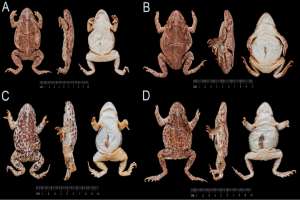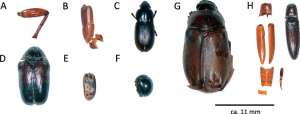Mesoamerican Toads
Hot off the presses! How does one correct a scientific error that was made more than 150 years ago? That’s what our team recently did, in collaboration with researchers from The Natural History Museum, in London, U.K. In 1858, renowned herpetologist Albert Günther, who was born in Germany but spent his career at The Natural History Museum in London, published a paper formally describing and naming a new species of toad from Ecuador that a collector had recently sold to the museum. He had four preserved specimens before him, purportedly from near Guayaquil, Ecuador, and he chose the scientific name Bufo intermedius. It’s not clear what is so “intermediate” about these particular toads, but that is the name he chose. Many years later, in 1932, an American herpetologist named Remington Kellogg published a classic review on everything that was known about Mexican frogs and toads at the time. While working on that masterpiece, he happened across those four toads that Günther had originally worked with, and mentioned casually that they sure looked an awful lot like a common species of Mexican toad called B. occidentalis—casting suspicion on the veracity of Günther’s work. But Kellogg did not take any formal taxonomic action on the matter and moved on with his work. In 1989, Dutch herpetologist Marinus Hoogmoed examined the toads and said, essentially, “I don’t what species these are, but there’s no way these originated from Ecuador.”


I have been studying Mesoamerican toads for a long time and, after several denied requests, finally got to examine these mysterious toads myself. I instantly agreed with both Kellogg and Hoogmoed: these were Bufo occidentalis and, therefore, must have come from Mexico and not possibly from Ecuador. But how to argue with the data tag with the specimens where the collector clearly indicated the source as Ecuador? Enter our heroes from the world of Entomology. Dr. Jeff Streicher, a collaborator on the project and the Curator of Herpetology at The Natural History Museum, noticed while he was preparing the photograph (below) that a slit had been made in the belly of one and some insect fragments from the stomach were visible. He asked his colleagues there in the Entomology Department to have a look and they stated emphatically that the species of beetles and ants in that stomach absolutely must have come from Mexico, and could not possibly be from Ecuador. Forensic entomology solved the mystery. Because the name B. occidentalis is an older original name than Günther’s 1858, the older name rules the day and the name B. intermedius has been formally retired and can never again be used to name any species. In recent years, the toads in Mexico are referred to the genus Incilius, so that common Mexican species is now known as Incilius occidentalis, and we all agree that there is not toad remotely like this species in Ecuador. Poor Günther was tripped up by a sloppy collector who labeled his specimens incorrectly, but it sure was a fun mystery for us to solve a century and a half later!
Joe Mendelson, PhD
Director of Research

Connect With Your Wild Side #onlyzooatl